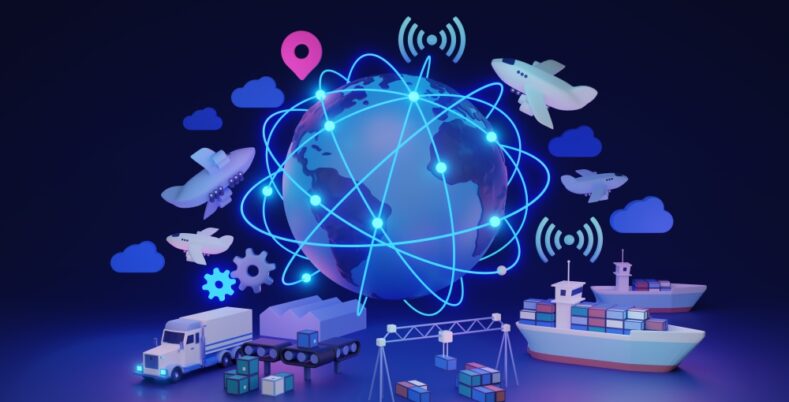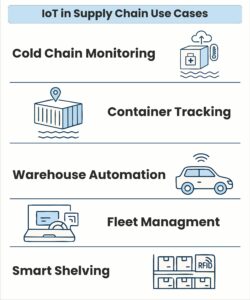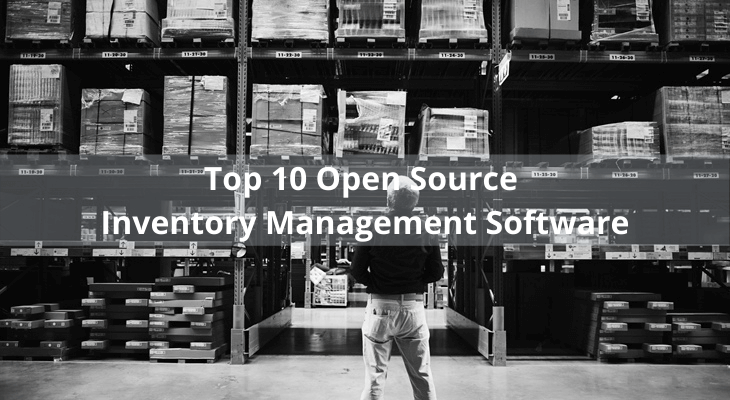Decades ago, inventory tracking was transformed by the simple barcode scanner, but modern supply chains are adopting something much more revolutionary. Delivery trucks, shipping containers, and warehouses have all been subtly invaded by Internet of Things technology. It has produced enormous networks of interconnected gadgets that can communicate in real time.
Near-perfect visibility from manufacturer to ultimate consumer is an enticing promise of the Internet of Things for businesses struggling with the difficulties of global supply management. However, businesses are finding that the path to supply chain transformation is filled with both amazing opportunities and unforeseen obstacles as they scramble to put these clever solutions into practice.
50% of major international corporations will use AI, advanced analytics, and IoT in supply chain management and logistics operations by 2025, predicts Gartner. The many perspectives of IoT in supply chain management will be discussed in this blog.
Role Of IoT in Supply Chain Management
IoT is the technology that allows supply chains to "feel" what's happening at every touch point. Smart sensors attached to pallets, containers, and vehicles constantly relay critical information about location, temperature, humidity, and handling conditions. Blind areas are converted into visible zones by this instantaneous data stream.
IoT creates an ecosystem where supply chain assets can think for themselves. A refrigerated truck carrying temperature-sensitive pharmaceuticals can automatically adjust cooling systems when sensors detect rising temperatures. Warehouse shelves can trigger reordering when inventory drops below threshold levels.
Logistics shift from reactive firefighting to proactive management due to self-regulating capabilities. It radically alters how businesses transport goods across ever-more intricate international networks. It allows management to recognize and resolve problems before they can become disruptions.
Benefits of IoT in Supply Chain Management
Enhanced Visibility: RFID tags and GPS-enabled sensors create unprecedented transparency across your entire supply network. It lets you track assets in real-time from factory floor to customer door.
Predictive maintenance: It reduces expensive downtime that can affect your entire business by having smart equipment continuously assess its own condition and notify maintenance staff before problems arise.
Demand Based Inventory: By adjusting stock levels in response to actual consumption patterns, connected inventory systems with edge computing capabilities help you avoid overstock and stockout situations that reduce your profits.
Optimization of Routes: Logistics teams can cut delivery times by rerouting cargo in response to weather, traffic patterns, or port congestion by using geofencing technology and telematics.
Challenges of IoT in Supply Chain Management
Many businesses find that integrating IT systems with their operational technology networks leads to unforeseen security issues. Every sensor, scanner, and linked gadget turns becomes a possible point of access for online thieves. Data leaks occur when companies implement IoT without fully addressing encryption standards or authentication procedures.
Beyond the obvious costs of sensors and connectivity hardware, there's the hidden expense of overhauling legacy systems that simply weren't designed to handle massive data streams. Without careful implementation planning, IoT deployments risk becoming expensive data collection exercises rather than transformative business tools.
Sensors generate mountains of information, but translating raw data into actionable business intelligence requires sophisticated analytics capabilities that many supply chain teams haven't developed yet. Companies often end up drowning in metrics while still missing the meaningful patterns that could actually improve operational efficiency.
Use Cases of Using IoT in Supply Chain Management
Cold chain monitoring
Continuous data are sent to cloud platforms via temperature sensors that are included in pharmaceutical shipments. They prevent expensive product spoilage and establish uninterrupted documentation chains that meet regulatory criteria.
Container tracking
Smart containers equipped with GPS and accelerometers can sense shocks and provide real-time position information. It makes it possible for logistics managers to immediately identify instances of expensive equipment being handled roughly during ocean shipment.
Warehouse automation
Autonomous mobile robots (AMRs) guided by beacon networks navigate warehouse aisles independently, collaborating with human pickers to slash fulfillment times during seasonal demand spikes.
Fleet management
Transportation managers may improve routes and cut down on needless idling by using connected vehicles with telematics systems to monitor driver behavior, vehicle diagnostics, and fuel consumption patterns.
Smart Shelving
With integrated RFID capabilities, weight-sensing retail shelves virtually do away with manual counting by automatically determining inventory levels and starting replenishment procedures when stock drops below predetermined thresholds.
Conclusion
IoT solutions will probably become more widely available and reasonably priced, and plug-and-play platforms will make connected technology available to even modest logistical businesses. However, the confluence of IoT and blockchain for unchangeable tracking data and machine learning for genuinely predictive logistics will be the real game-changer.
To know more about IoT in Supply Chain Management, keep reading our blogs at KnowledgeNile.
Keep Exploring:
Use Cases Of RPA In Supply Chain: List Of The Best Tools
Digital Twin In Supply Chain: How Can It Transform The Industry
Understanding Supply Chain Management: Its Importance and Impact






